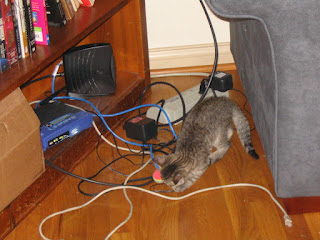 To the left is the view from my room. It is sunnier this morning, but yesterday I enjoyed watching the fog (or perhaps that is rain?) in the valley lift up and re-descend. Jet lag here isn't so bad; I like the concept of being a morning person, but in practice it never holds.
To the left is the view from my room. It is sunnier this morning, but yesterday I enjoyed watching the fog (or perhaps that is rain?) in the valley lift up and re-descend. Jet lag here isn't so bad; I like the concept of being a morning person, but in practice it never holds.
The conference kicked off yesterday morning with a talk by John Tonry on Synoptic Sky Surveys. Essentially, the Sloan Digitial Sky Survey (SDSS) is coming to a close. Sloan has mapped about a fifth of the sky in visible wavelengths, with stupidly large numbers of cataloged stars, galaxies, quasars, and what-have-yous. I think in some ways the holy grail of observational astronomy is to have the entire sky mapped down to the faintest magnitudes possible, at all wavelengths, and to continually observe the entire sky for time variability. According to Tonry, we are rapidly approaching the first goal for visible wavelengths; it is likely that in ten to twenty years, the entire optical sky will be mapped down to the faintest magnitude allowed by the atmosphere. Surveys like Pan-STARRS and SkyMapper are coming online this year. In 15 years, will astronomy be a field of searching databases and waving the wand of statistics, or are we practically already there with SDSS?
After the first talk, everyone trickled down to the room with the posters and exhibits; more specifically, the room with the pastries and coffee. I like going around to the exhibits and talking to the people there; I've already collected half a dozen bookmarks (to make up for forgetting to bring one with me) and more stickers than I know what to do with.
Then it was time to break into individual sessions, with five minute "normal" talks and fifteen minute "disseratation" talks. Several people simply did not show up to give their talk in a few of the sessions I attended; I cannot understand how someone can not only just not "show up," but also be rude enough to not inform the organizers that their plans have changed. I managed to miss most of the talks I had wanted to go to, since I was skipping around the galaxy evolution and galaxy cluster and variable star sessions, but most of the talks I heard were in fact interesting.
At lunch, I found myself with a solar physics group from Boulder, Colorado. This meeting is in conjunction with the Solar Physics Division, which is to say, there are a lot of astronomers here who have taken the "day shift." The sun is fascinating; one would think that being the nearest star, we would know everything about it we might want to. But people don't even agree on simple-seeming things, like the amount of oxygen relative to hydrogen. It is also an interesting field in that we can measure all sorts of things from the sun that we can't in other stars: details of sunspots, coronal mass ejections, granulation, helioseismology, sun flares, etc. etc.—things we would looooove to know about Other Stars, but we just can't make the measurements yet. After all, the sun is just a star, and what we really want to know about is stars, and in many plots, we only have the one data point. A few of the solar folks I talked to are excited about the upcoming missions to search for extrasolar planets; by making exquisitely accurate measurments of the light coming from stars, we can also hope to learn about astroseismology (literally, starquakes) of stars not our own.
Speaking of extrasolar planets, apparently the big news release yesterday was on a bunch of new ones being announced. (One of the breakout sessions yesterday was on extrasolar planets, but I did not go.) There have been rumors circulating for months that 2007 will see a huge increase in the number of known extrasolar planets; many of the ongoing searches for transiting planets are finally coming to fruition. It is heartening to see people announcing more than a handful of planets at a time; it means that the field is growing from one of stamp collecting to one in which they can actually do statistics and begin to really learn about planet formation.
In the afternoon, I went to the COSMOS session. I have a soft spot for the COSMOS project since it was my first real introduction to astronomy; the summer I spent at Caltech in 2004 was centered on playing with all of the HST COSMOS data that was available at the time (about half of it). It's a gorgeous data set. Apparently the S-COSMOS data set, the Cycle 2 Spitzer data of the COSMOS field, is now available. Many of the talks were about these infrared bright galaxies, though the talk I found most intriguing was the one on asteroids found in the COSMOS field with Spitzer: one person's trash is another's science.
After all of the talks, I went over to some nearby beach with a group of graduate students mostly from the University of Hawaii. Yesterday being Memorial Day, there was a Lantern Floating ceremony; people light little lanterns on little boats in remembrance of lost ones, and at sunset let them out into the sea. There was music and ceremony and many many people. I took lots of pictures, but none of them are very good. I didn't care much for the overly fancy rituals projected onto the big screen by the people running the shindig, but watching the people who had brought their own personal lantern boats walk to the ocean, I think I like this way of honoring and remembering the dead. As the sky grew darker, the water became more and more littered with bright lights.

 They are very blue and what we astronomers called "disturbed." That's fancy-talk for "they've been playing rough with their neighbors and so their gas and stars have been all moved around so they look morphologically... disturbed." The key here is that simulations have shown that as galaxies interact, gas from really large scales will typically get drained into the centers of the galaxies. As it turns out, this large-scale gas will generically have a much lower metallicity than the gas originally at the galaxy center, so the large-scale gas inflow will effectively dilute the central gas. Relative to the amount of time we can expect for the star-formation to continue, it won't take very long for this new gas to get re-enriched by metals formed during the star formation itself, so we can expect for these luminous low-metallicity galaxies to be relatively rare.
They are very blue and what we astronomers called "disturbed." That's fancy-talk for "they've been playing rough with their neighbors and so their gas and stars have been all moved around so they look morphologically... disturbed." The key here is that simulations have shown that as galaxies interact, gas from really large scales will typically get drained into the centers of the galaxies. As it turns out, this large-scale gas will generically have a much lower metallicity than the gas originally at the galaxy center, so the large-scale gas inflow will effectively dilute the central gas. Relative to the amount of time we can expect for the star-formation to continue, it won't take very long for this new gas to get re-enriched by metals formed during the star formation itself, so we can expect for these luminous low-metallicity galaxies to be relatively rare.











